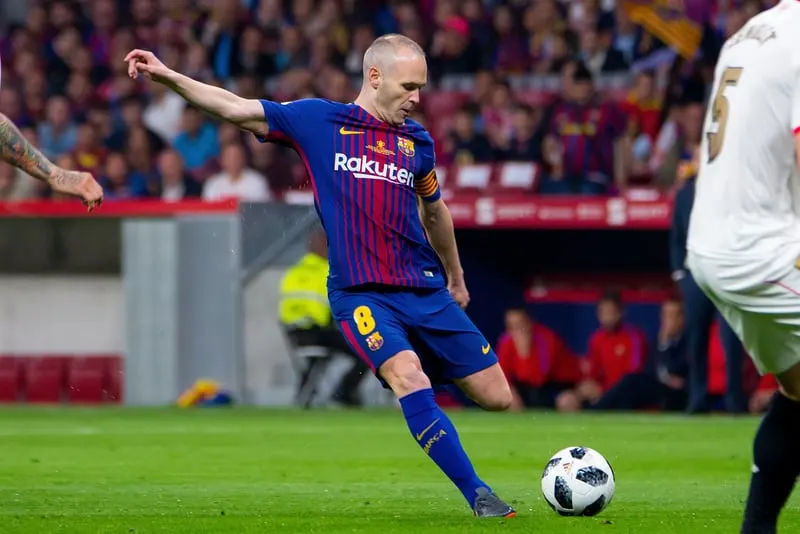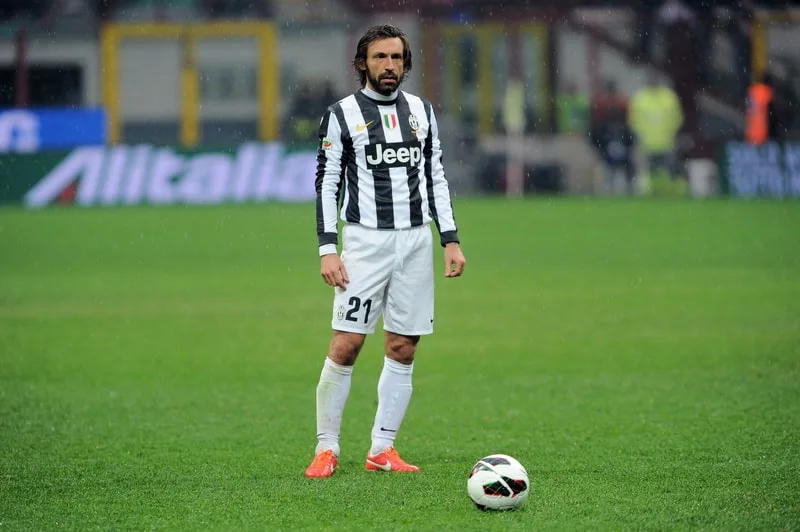
The hardest thing to do in soccer is scoring a goal, and as such, a quality striker is worth their weight in gold. But what if you had in your team a player of such vision and skill that they could make it easier for any player to score?
We are of course talking about the playmaker, the one that pulls the strings, the player with the eye for a killer pass, and the one that makes your team tick.
If a great striker is worth their weight in gold, is the perfect playmaker worth five times that? Their ability to orchestrate a game, the way they make even the most mediocre of teammates look good, a playmaker make everyone better.
Think quarterback, and you won’t be far wrong. The best teams in the NFL usually have some of the best quarterbacks, they see the game as a whole, directing play and making things happen for their team.
Here’s everything you need to know about a playmaker in soccer.
What Positions Can Playmakers Play In?

While the midfield area is certainly the domain of the playmaker, there is some leeway in regards to what positions playmakers can take.
Skill certainly plays a part here, the better the player, the less restricted they are in regards to their position. Deep-lying playmakers such as Andrea Pirlo sat just in front of the defense and used his passing skills to spray the ball to attackers, cutting out much of the midfield.
Pirlo did this in part because he had the talent to sit even further back, and also because he had no pace to speak of. Bombing forwards with the ball simply didn’t suit his game, so he removed it.
Another favorite position for playmakers is the traditional number 10, a striker/attacking midfielder that starts the game as part of a front two, but then drops deep to recover the ball from their midfielders and create that spark of magic.
An excellent example of this type of player is Dennis Bergkamp, the now-retired Arsenal forward who spent 11 years at the London club as a striker that would drop deep to become the teams’ creative outlet.
As soccer progresses we find more playmakers taking to the wings of the pitch to find space, players such as Lionel Messi and Cristiano Ronaldo have career stats that would make most teams weep, and both have made cutting inside from the wing their signature moves.
Ultimately a players position is less relevant than their level of skill, the team knows who their creative outlet is and as such will always try to get the ball to them as quickly as possible. Which is why we are seeing much more leeway in the starting positions of key playmakers.
What Makes A Great Playmaker?

The most important skills for a playmaker is:
- Vision
- Ball Control
- Flair
Midfield is the playmakers’ playground, the ball is there for longer, and because of that, most, although not all, great playmakers are central midfielders.
While pace is certainly a valued asset for the modern player, a gifted playmaker makes the ball do all the running for them, so passing ability is much higher on their list of attributes.
Having the ability to be able to place the ball onto a teammate’s foot from 50 yards away is a massive bonus, ball transition is quicker as the midfield outlet moves the ball from defense to attack in a heartbeat.
Strength on the ball is another great attribute, if your opponent can’t get the ball from you, you are less likely to concede. But again, this is not the be-all and end-all for playmakers, who rely on speed of thought and positioning to a greater extent.
All of the greatest playmakers of all time, and it is even more true today due to the increased speed of the modern game, had the uncanny ability to find space, use it wisely, and look as if they were thinking three moves ahead of everyone else.
The reason these players looked like they were thinking three moves ahead was usually that they were. A feel for the ebb and flow of the game as well as knowing exactly where every player is around them allows the playmaker to do just that: make the plays.
Ball control, dribbling, and flair make up the other key ingredients for a master playmaker, instant ball control gives the player more time to react and make the next pass, dribbling allows them to skip past players as they look to move forwards.
Vision and Flair
Flair is much more intangible, players such as Xavi Hernandez for Barcelona was a magnificent player, capable of the sublime, but usually only took two touches of the ball, to devastating effect.
A key component of Pep Guardiolas’ Barcelona team, Xavi spent a decade dictating play and being his teams’ main creative outlet. But rather than being full of tricks and creativity, Xavi saw the game unfold many moves ahead.
Upon receiving the ball, he would take one touch and then recycle the ball, never lost possession, and always looked to keep his team on the offensive.
Whereas his teammate Lionel Messi would get the ball to feet, turn and run at players, skipping past challenges and playing a devastating pass or scoring another world-class goal.
These two examples show the different playstyles, both equally effective, and both completely contrasting in their operation, that turned Barcelona into the best team in the world.
So, our perfect playmaker has vision, flair, passing ability, and positional awareness, but what about creativity? A creative midfield playmaker can make something happen out of nothing, the vision to stop a killer opportunity is only worthwhile if the playmaker has the creativity to pull it off.
Teammates Need To Be On The Same Wavelength

Something else that a playmaker needs is teammates who can adapt to their ideas, a cunning through ball to an unwary striker will always look like a bad pass if the striker never actually goes after the ball.
While a star playmaker is rightly adored by the fans, and gratefully appreciated by their teammates, there is a real need for the team to get a feel for what is about to happen.
Training games are vital for teams to gel together, the more in tune with what your teams’ playmaker is thinking you are, the greater the chance of success. And because of their speed of thought and their unpredictability, the harder it is for opponents to react.
Are All Playmakers Number 10s?

The most famous playmakers have played either as a central midfielder or as a number 10 (image above shows number 10 position).
While shirt numbers are less relevant in the modern game, as players often choose numbers well outside the 1-11 range, it is worth mentioning that many of the greatest playmakers of all time generally held shirt numbers for specific positions.
Wearing the number 5 shirt throughout his career, Franz Beckenbauer was definitely not your standard playmaker. Playing as a sweeper, the West Germany legend could be found marauding upfield with the ball, creating chance after chance.
Even today, decades after retirement, there has not really been another sweeper that has taken up the mantle of creative player in the same way Beckenbauer did throughout his incredible career.
Italians love a creative playmaker, and some of the best in history hail from Serie A, and to Italians the number 10 shirt is almost hallowed in its reverence.
One such player that turned the number 10 shift into his own was Roberto Baggio, dubbed the “Divine Ponytail”, Baggio was a creative artist with few peers and became one of the most loved players Italy has ever had.
With a sublime passing ability, excellent shooting skills, and a flair that took the breath away, the Italian striker often dropped into a deeper role to orchestrate play and is rightly regarded as one of the greatest playmakers of all time.
Another world-class playmaker was Francesco Totti, the Roma captain and talisman throughout the ’90s and 2000s, a number 10 that oozed class and talent.
Totti could play in any position, such was his technical brilliance, linking play between midfield and attack, and chipping in with a ridiculous number of goals and assists throughout his career.
Continuing our theme of a playmaking number 10, to cement the number as the de-facto shirt for playmaking genius, we need to look no further than Zinedine Zidane and Diego Maradona.
Both were sublime players with almost god-like adoration from fans, both were creative geniuses that could take apart an opposing team almost at will. In fact, both players are the perfect examples of just what makes a playmaker so popular, both were serial winners.
Are Great Playmakers Great Goalscorers?

Some of the best-known playmakers in soccer have also been known as scorers of truly great goals. The aforementioned Maradona, Zidane, and Totti were all great at linking the play but were also known for their goalscoring exploits.
Be it from open play or direct free-kicks, many of the most well-known playmakers had the ability to put the ball in the back of the net. But while that may be why they are just so well known, their primary goal is, and always has been, creating goalscoring opportunities.
Ask most fans of Andrea Pirlo what they remember most about him and you may very well get the answer that it’s his free-kicks that they remember most.
But ask his teammates or managers, and the likely response will be the effortless way in which he carved teams apart, creating chance after chance for his team from his deep-lying playmaker position.
Is There A Future For Playmakers?
Playmakers will become even more important to teams in the future as tactics and teams evolve in the modern game. We only need to look at the Manchester City team of Pep Guardiola to see the need for quick-thinking playmakers.
Manchester City is a team of superstars, they are however lacking in the striker department. Guardiola has made several attempts to buy a new striker, most notably Harry Kane from Tottenham Hotspurs, but as yet has had no luck.
Rather than panic buying players, Guardiola has relied on a team full of playmakers, going on the assumption that creatively, his team cannot be matched in terms of chance creation.
And so far he has been proven right, City sit atop of the Premier League table, is winning consistently, and creating chance after chance due to a midfield packed with playmakers, all contributing with goals and assists as his team destroys opponents through sheer creativity and skill.
Given that intricate passing and tiki-taka are becoming more prevalent in soccer, the need for clever players that can unlock teams is becoming more urgent.
The teams that are unable to use the tiki-taka style invariably have to sit back and put 11 players behind the ball, desperately trying to “park the bus”, which has the knock-on effect of the top teams needing even more creative players with which to unlock these defenses.
And so the cycle continues, playmakers are here to stay, and given the excitement they bring to the game, we’re all for that.
